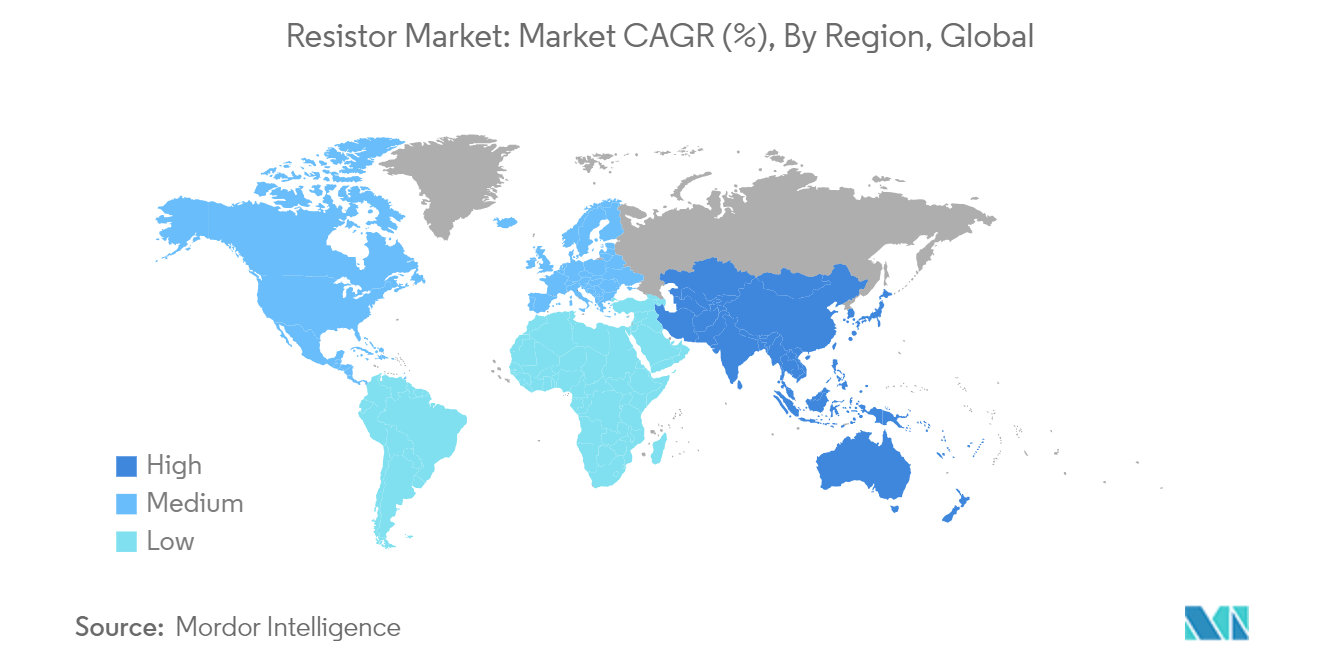Market Trends of Resistor Industry
Consumer Electronics Segment to Dominate the Market
- Resistors are one of the most commonly used passive components in electronic circuits because they resist the flow of sudden voltage spikes, which are enough to cause damage to electronic equipment almost instantly. Multiple resistor types find widespread application in consumer electronics such as computers, PCs, and notebooks.
- Surface-mount chip resistors are tiny and used significantly for printed circuit boards (PCBs) incorporated in smartphones and laptops, and most silicon-printed circuits use them for operations that ensure signals are always right. Also, varistors, often described as movistors (a contraction of the words metal oxide varistor), are among the types of resistors available in various forms. They are significantly utilized in the surge or transient-protected mains extension to protect computers by varying the resistance with the applied voltage.
- Common types of resistors found in smartphones include surface-mount chips and network resistors. Chip resistors are one of the smallest electronic components on the PCB of a mobile phone. They decrease the current and pass it forward. Network resistors are made from two or more chip resistors. For instance, Chip Resistors Array's offering from Walsin Technology Corporation is applied to mobile phones, digital camcorders, and other consumers' electrical equipment.
- As consumer electronics continue to advance, there have been changes in the power and pulse requirements. The development of more efficient electronics means that lower power, voltage, and current conditions are now necessary. Consequently, designs that previously relied on costly carbon composition or wire-wound resistors can now opt for the more affordable metal oxide option. Although metal oxide resistors may not be able to withstand as much pulse energy as carbon comps or wire wounds, they still offer improved pulse handling compared to standard metal film resistors.

Asia-Pacific to Hold Significant Market Share
- The growing electronics industry is attracting several MNCs to establish manufacturing plants in Asian countries, either independently or through a joint venture with different regional companies. This includes large global organizations such as Tyco Electronics, FCI OEN, Molex, Vishay, and EPCOS. This is further anticipated to boost the local manufacturing activity of resistors in the Asia-Pacific region.
- In China, the demand for passive electronic components like resistors is primarily driven by the growth of consumer electronics. Moreover, China's Ministry of Industry and Information Technology released an action plan to develop the country's electronic components industry from 2021 to 2023. The action plan aims to achieve technological breakthroughs in areas including circuits, connectors, sensors, and optical communication components to enhance the position of Chinese companies in the industrial supply chain and ease supply reliance on high-end foreign products. This plan will unlock new opportunities for industry players in the region.
- The strong demand for notebooks and gaming machines supporting the stay-at-home economy and the gradual pickup in demand for handsets and automotive applications have influenced several companies to increase their productivity.
- The trading of resistors in countries like India is witnessing an upsurge, especially with surging demand for current sense resistors. However, thin film and chip resistors currently have relatively lower demand in the Indian market. This trend indicates the lack of specialized electronic product manufacturing in the country that uses such resistors. However, most manufacturers still perceive that the future of resistor manufacturing lies in thick film and chip resistors.
- Asian companies, such as Taiwan-based Yageo, are engaging in multiple product innovation activities. YAGEO Group has developed one of the smallest metal current sensing resistors, PA0100 (01005 sizes, 0.4mm x 0.2mm). PA0100 metal current sensing resistors are mainly adopted in light, thin, multi-functional, short, and high-density mobile devices such as smartphones, battery modules, wearable devices, and radiofrequency transceiver modules.


